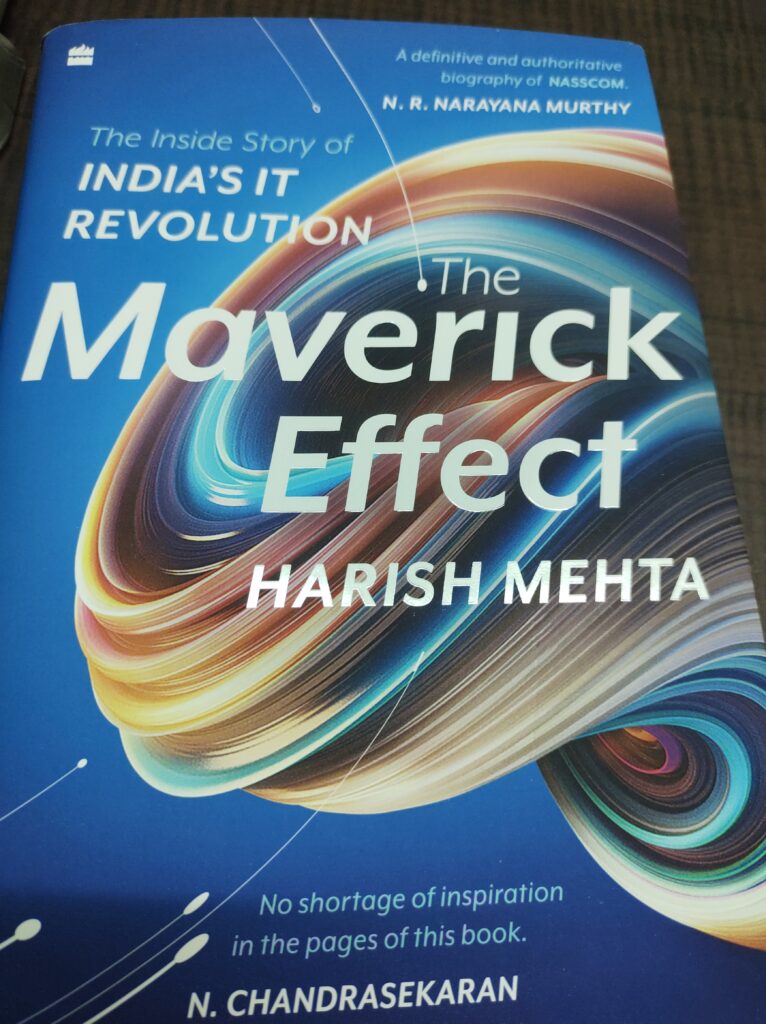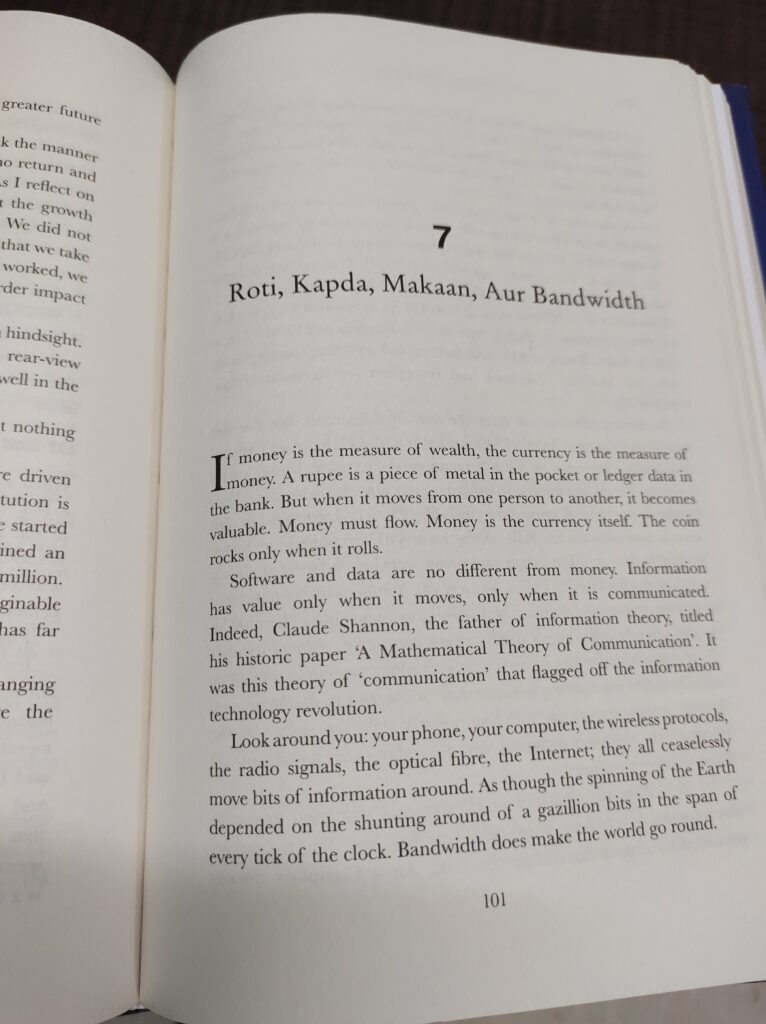

“Data links were not just bad; they were expensive. Today, project managers do not think about data transfer costs, but in those days, we would keep aside 7-10 per cent of our revenues for it. A 64 kbps link used to cost Rs.20,00,000 per year in the 1990s. With such a high upfront cost, many were deterred from starting a software services business. If there was ever a need for an industry association, this was the time”
- –From the chapter ‘Roti, Kapda, Makaan, Aur Bandwidth’ .
Of all the chapters in the book—The Maverick Effect—this is the one that I could relate to the most. As software developer in a company that shared a 64 kbps line with many others in STPI housed building to a senior executive in an internet company that leased dedicated lines across India to set up a class-A ISP, I had a firsthand experience of the initial growth of internet in India. It is heartening to know behind-the -scenes effort of VSNL, NASSCOM and a host of others, to usher in the India’s Internet revolution.
The book speaks to anyone and everyone remotely connected to the IT industry with his or her career overlap in the 1990s.
Even if you are not in this group, the book offers several management insights with the help of various incidents in NASSCOM and the author’s professional journey. For instance, the process involved in hiring Late Dewang Mehta and then subsequently that of Mr.Kiran Karnik, two very different individuals, yet so right at the time of their hiring. The other is when NASSCOM played an important role in the aftermath of Satyam’s calamity in keeping things afloat by rallying the support of Indian companies and that of Satyam’s clients across the world, ala Apollo 13 mission of NASA.
Mr.Harish Mehta succeeds in not only providing a vivid account as to how ‘IT’ all happened in India but also connecting with the current generation with his advice on new technologies’ development.
Few Snippets from the book.
- (Page 22) I also experienced conflicting aspects of everyday life in the US. I soon learned that I lived in an area with an extraordinarily high crime rate. On the way to the college, we would have to cross a park where the possibility of being mugged loomed largely. I was told to keep a minimum of $5 with me not having any money for the mugger was a certain way to get beaten up. I didn’t have any insurance, which made the mere thought of being harmed even scarier.
- (Page 15) Attending the pathshala during my formative years exposed me to the illuminating tenets of Jainism, such as ahimsa, aparigraha, sweekar and anckaantyaad.
- Ahimsa is non-violence, widely known and practised in India, thanks to Gandhiji’s pervading influence.
- Aparigraha espouses selflessness and detachment from results and material life. Sweekar the acceptance of adverse outcomes and uncontrollable events in life, is critical to a mind that seeks to endure and progress with equanimity.
- Sweekar views hurdles as building blocks in the path to the future. I think I owe many of my successes to sweekar because it gave me the grit and the acceptance that is so essential in business.
- And lastly, anekaantvaad is special to me. Anekaantvaad embraces multiple truths instead of just one. There can be varied reasons behind the existence of multiple truths. It could be the limitations of words, language, thinking, logic, emotions or the senses. It is special because it became the kernel of my life, and helped me resolve personal and professional dilemmas.
- (Page 46) So, quite ironically, we roped in MATT’s founder president, Prem Shivdasani, who had the experience we needed because of his work on its constitution. Then we went shopping around Delhi’s Connaught Place. There, we visited the offices of the Federation of Indian Chambers of Commerce and Industry (FICCI) and the Confederation of Indian Industry (CII) and asked for copies of their constitutions. Back in Mumbai, we also checked out the constitution of the Computer Society of India (CSI) and the Indian Merchants’ Chamber (IMC). With all this material on the desk, the core team started debating the finer points of our draft constitution. We met several times in my office, at the Bombay Gymkhana and in Adi Cooper’s office. Adi was an advisor to Tata Infotech at that time. He was close to Kohli and continued with the Tatas in this capacity, even though he had quit the group after thirteen years of service. He was one of the first believers in our association and was part of the core team from the very start. Among those in this effort were core team pioneers like Ashank Desai and Sonata Software’s Kanak Pandyan. As work progressed, many more got involved with varying levels of enthusiasm. We had begun to roll. Majrooh Sultanpuri would have summed it up thus: ‘Log saath aate gae aur karvan banta gaya.’
- (Page 56) Our experience with Anil gave us an important lesson in managing people and their expectations. We were probably not clear in defining the role and that probably created this mismatch.
- (Page 126) This mindset is the exact opposite of the one needed. A software entrepreneur must trust a large number of people within an organization, build systems and relinquish control.
- (Page 128) Chandrababu Naidu
- (Page 140) Eventually, all kinds of complex projects were executed all over the world. Indian IT was doing it all. Delivery models ranged from outsourcing to right-sourcing; from being a quality destination to a trusted sourcing nation; from on-site to offshore, to nearshore; from data migration to complex projects like the modernization of the London Underground’s signalling systems that ensures zero train collision and to business transformation projects and more.
- (Page 147) Some people say India in general and software services in particular lack innovation. To them, I point out that the innovation is in the processes we have built in the software services business. I think former HP CEO Carly Fiorina summed it up at one NASSCOM India Leadership Forum (NILF) session, “You set out to change India, but you ended up changing the world with the outsourcing business model that you people have innovated.”
- (Page 234) Further, from school-going children becoming instant experts on technology to seniors adapting to video-communication tools, no stratum has been left untouched by the impact and utility of technology The rate of technology adoption has made even the hockey-stick curve look flat.
